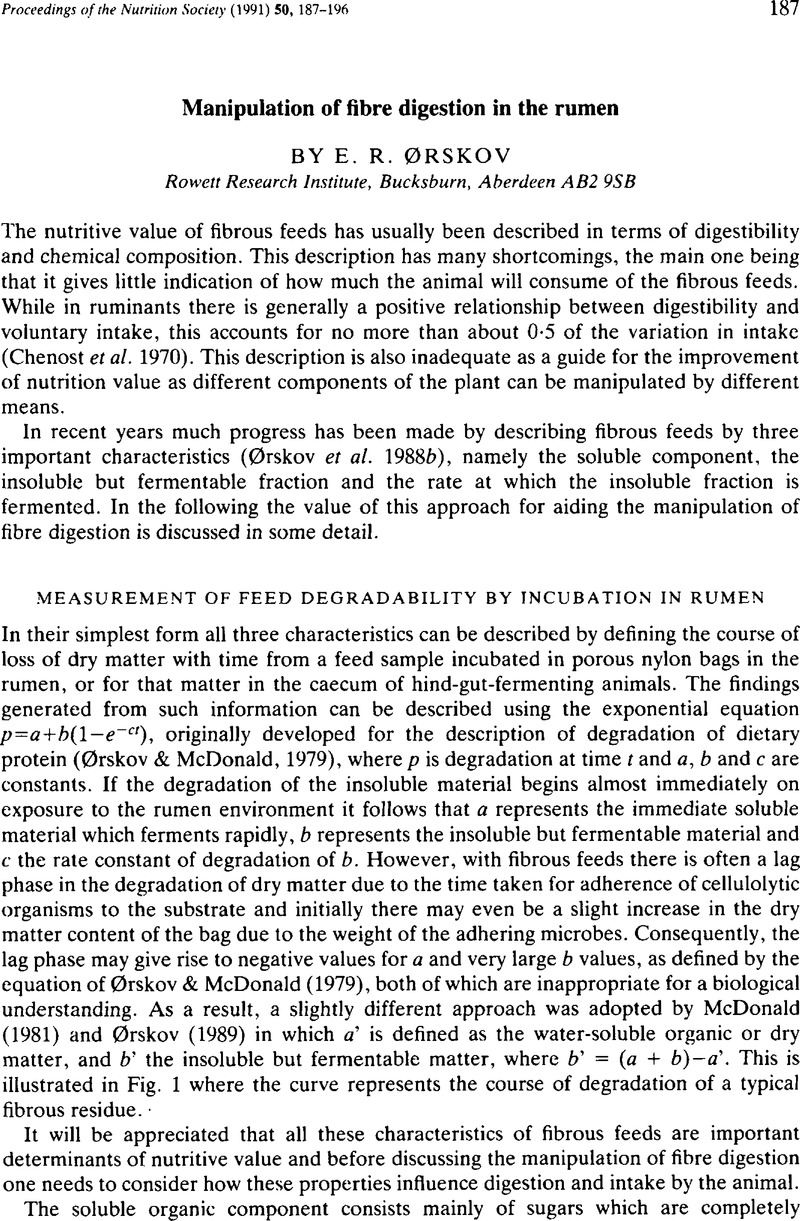Crossref Citations
This article has been cited by the following publications. This list is generated based on data provided by Crossref.
Makkar, Harinder P S
Blümmel, Michael
Borowy, Norbert K
and
Becker, Klaus
1993.
Gravimetric determination of tannins and their correlations with chemical and protein precipitation methods.
Journal of the Science of Food and Agriculture,
Vol. 61,
Issue. 2,
p.
161.
Tolera, Adugna
Sundstøl, Frik
and
Said, Abdullah N
1998.
The effect of stage of maturity on yield and quality of maize grain and stover.
Animal Feed Science and Technology,
Vol. 75,
Issue. 2,
p.
157.
Ferri, C. M.
Jouve, V. V.
Stritzler, N. P.
and
Petruzzi, H. J.
1998.
Estimation of intake and apparent digestibility of kleingrass from in situ parameters measured in sheep.
Animal Science,
Vol. 67,
Issue. 3,
p.
535.
Larbi, A.
Dung, D.D.
Olorunju, P.E.
Smith, J.W.
Tanko, R.J.
Muhammad, I.R.
and
Adekunle, I.O.
1999.
Groundnut (Arachis hypogaea) for food and fodder in crop-livestock systems: forage and seed yields, chemical composition and rumen degradation of leaf and stem fractions of 38 cultivars.
Animal Feed Science and Technology,
Vol. 77,
Issue. 1-2,
p.
33.
Krause, D. O.
Bunch, R. J.
Smith, W. J. M.
and
McSweeney, C. S.
1999.
Diversity of Ruminococcus strains: a survey of genetic polymorphisms and plant digestibility.
Journal of Applied Microbiology,
Vol. 86,
Issue. 3,
p.
487.
Tolera, Adugna
and
Sundstøl, Frik
1999.
Morphological fractions of maize stover harvested at different stages of grain maturity and nutritive value of different fractions of the stover.
Animal Feed Science and Technology,
Vol. 81,
Issue. 1-2,
p.
1.
Galina, M.A.
Guerrero, M.
Serrano, G.
Morales, R.
and
Haenlein, G.F.W.
2000.
Effect of complex catalytic supplementation with non-protein nitrogen on the ruminal ecosystem of growing goats pasturing on shrub land in Mexico.
Small Ruminant Research,
Vol. 36,
Issue. 1,
p.
33.
Ferri, C. M.
Stritzler, N. P.
Petruzzi, H. J.
and
Cerqueira, E. D.
2000.
Effect of amount ofPanicum virgatumhay offered on intake, apparent digestibility and short-term intake rate of rams.
Animal Science,
Vol. 71,
Issue. 2,
p.
341.
Galina, M.A.
Pérez-Gil, F.
Ortiz, R.M.A
Hummel, J.D.
and
Ørskov, R.E.
2003.
Effect of slow release urea supplementation on fattening of steers fed sugar cane tops (Saccharum officinarum) and maize (Zea mays): ruminal fermentation, feed intake and digestibility.
Livestock Production Science,
Vol. 83,
Issue. 1,
p.
1.
Ubani, ON
Tewe, OO
and
Smith, J
2004.
Rumen dry matter degradation of tree species by West African dwarf goats.
Tropical Science,
Vol. 44,
Issue. 1,
p.
6.
Ozturk, D.
Bal, M.A.
Erol, A.
Sahin, M.
Ozkan, C.O.
Karakas, E.
Ata, M.
and
Karabay, P.
2006.
Determination of Nutritive Value of Wild Chicory (Cichorium intybus) Forage Harvested at Different Maturity Stage Using in vitro and in situ Measurements.
Pakistan Journal of Biological Sciences,
Vol. 9,
Issue. 2,
p.
253.
Ortiz-Rubio, M.A.
Ørskov, E.R.
Milne, J.
and
Galina, H.M.A.
2007.
Effect of different sources of nitrogen on in situ degradability and feed intake of Zebu cattle fed sugarcane tops (Saccharum officinarum).
Animal Feed Science and Technology,
Vol. 139,
Issue. 3-4,
p.
143.
Patra, A. K.
2010.
Effects of supplementing low‐quality roughages with tree foliages on digestibility, nitrogen utilization and rumen characteristics in sheep: a meta‐analysis.
Journal of Animal Physiology and Animal Nutrition,
Vol. 94,
Issue. 3,
p.
338.
Larbi, A.
Hassan, S.
Kattash, G.
El-Moneim, A.M. Abd
Jammal, B.
Nabil, H.
and
Nakkul, H.
2010.
Annual feed legume yield and quality in dryland environments in north-west Syria: 1. Herbage yield and quality.
Animal Feed Science and Technology,
Vol. 160,
Issue. 3-4,
p.
81.
Larbi, A.
Abd El-Moneim, A.M.
Nakkoul, H.
Jammal, B.
and
Hassan, S.
2011.
Intra-species variations in yield and quality determinants in Vicia species: 4. Woolly-pod vetch (Vicia villosa ssp. dasycarpa Roth).
Animal Feed Science and Technology,
Vol. 164,
Issue. 3-4,
p.
252.
Reid, R.L.
2015.
Forage Quality, Evaluation, and Utilization.
p.
1.
Miccoli, Florencia E.
Arelovich, Hugo M.
Martínez, Marcela F.
Bravo, Rodrigo D.
and
Menghini, Mariano
2018.
The impact of hydrolyzing and oxidizing agents on chemical composition and digestibility of various high‐fibre forages.
Grass and Forage Science,
Vol. 73,
Issue. 3,
p.
705.
Huang, Y.F.
Matthew, C.
Li, F.
and
Nan, Z.B.
2021.
Common vetch varietal differences in hay nutritive value, ruminal fermentation, nutrient digestibility and performance of fattening lambs.
Animal,
Vol. 15,
Issue. 7,
p.
100244.
Suntara, Chanon
Sombuddee, Napudsawun
Lukbun, Saowalak
Kanakai, Natdanai
Srichompoo, Pachara
Chankaew, Sompong
Khonkhaeng, Benjamad
Gunun, Pongsatorn
Gunun, Nirawan
Polyorach, Sineenart
Foiklang, Suban
and
Cherdthong, Anusorn
2023.
In Vitro Evaluation of Winged Bean (Psophocarpus tetragonolobus) Tubers as an Alternative Feed for Ruminants.
Animals,
Vol. 13,
Issue. 4,
p.
677.



